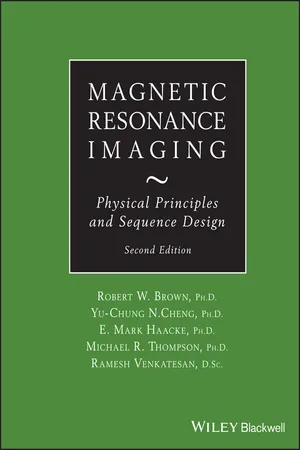
Magnetic Resonance Imaging
Physical Principles and Sequence Design
- English
- ePUB (mobile friendly)
- Available on iOS & Android
Magnetic Resonance Imaging
Physical Principles and Sequence Design
About this book
New edition explores contemporary MRI principles and practices
Thoroughly revised, updated and expanded, the second edition of Magnetic Resonance Imaging: Physical Principles and Sequence Design remains the preeminent text in its field. Using consistent nomenclature and mathematical notations throughout all the chapters, this new edition carefully explains the physical principles of magnetic resonance imaging design and implementation. In addition, detailed figures and MR images enable readers to better grasp core concepts, methods, and applications.
Magnetic Resonance Imaging, Second Edition begins with an introduction to fundamental principles, with coverage of magnetization, relaxation, quantum mechanics, signal detection and acquisition, Fourier imaging, image reconstruction, contrast, signal, and noise. The second part of the text explores MRI methods and applications, including fast imaging, water-fat separation, steady state gradient echo imaging, echo planar imaging, diffusion-weighted imaging, and induced magnetism. Lastly, the text discusses important hardware issues and parallel imaging.
Readers familiar with the first edition will find much new material, including:
- New chapter dedicated to parallel imaging
- New sections examining off-resonance excitation principles, contrast optimization in fast steady-state incoherent imaging, and efficient lower-dimension analogues for discrete Fourier transforms in echo planar imaging applications
- Enhanced sections pertaining to Fourier transforms, filter effects on image resolution, and Bloch equation solutions when both rf pulse and slice select gradient fields are present
- Valuable improvements throughout with respect to equations, formulas, and text
- New and updated problems to test further the readers' grasp of core concepts
Three appendices at the end of the text offer review material for basic electromagnetism and statistics as well as a list of acquisition parameters for the images in the book.
Acclaimed by both students and instructors, the second edition of Magnetic Resonance Imaging offers the most comprehensive and approachable introduction to the physics and the applications of magnetic resonance imaging.
Frequently asked questions
- Essential is ideal for learners and professionals who enjoy exploring a wide range of subjects. Access the Essential Library with 800,000+ trusted titles and best-sellers across business, personal growth, and the humanities. Includes unlimited reading time and Standard Read Aloud voice.
- Complete: Perfect for advanced learners and researchers needing full, unrestricted access. Unlock 1.4M+ books across hundreds of subjects, including academic and specialized titles. The Complete Plan also includes advanced features like Premium Read Aloud and Research Assistant.
Please note we cannot support devices running on iOS 13 and Android 7 or earlier. Learn more about using the app.
Information
Chapter 1
Magnetic Resonance Imaging: A Preview
Introduction
1.1 Magnetic Resonance Imaging: The Name
1.2 The Origin of Magnetic Resonance Imaging
Table of contents
- Cover
- Title page
- Copyright page
- Foreword to the Second Edition
- Foreword to the First Edition
- Dedication
- Preface to the Second Edition
- Preface to the First Edition
- Acknowledgments
- Acknowledgments to the First Edition
- Chapter 1: Magnetic Resonance Imaging
- Chapter 2: Classical Response of a Single Nucleus to a Magnetic Field
- Chapter 3: Rotating Reference Frames and Resonance
- Chapter 4: Magnetization, Relaxation, and the Bloch Equation
- Chapter 5: The Quantum Mechanical Basis of Precession and Excitation
- Chapter 6: The Quantum Mechanical Basis of Thermal Equilibrium and Longitudinal Relaxation
- Chapter 7: Signal Detection Concepts
- Chapter 8: Introductory Signal Acquisition Methods
- Chapter 9: One-Dimensional Fourier Imaging, k-Space, and Gradient Echoes
- Chapter 10: Multi-Dimensional Fourier Imaging and Slice Excitation
- Chapter 11: The Continuous and Discrete Fourier Transforms
- Chapter 12: Sampling and Aliasing in Image Reconstruction
- Chapter 13: Filtering and Resolution in Fourier Transform Image Reconstruction
- Chapter 14: Projection Reconstruction of Images
- Chapter 15: Signal, Contrast, and Noise
- Chapter 16: A Closer Look at Radiofrequency Pulses
- Chapter 17: Water/Fat Separation Techniques
- Chapter 18: Fast Imaging in the Steady State
- Chapter 19: Segmented k-Space and Echo Planar Imaging
- Chapter 20: Magnetic Field Inhomogeneity Effects and T2* Dephasing
- Chapter 21: Random Walks, Relaxation, and Diffusion
- Chapter 22: Spin Density, T1, and T2 Quantification Methods in MR Imaging
- Chapter 23: Motion Artifacts and Flow Compensation
- Chapter 24: MR Angiography and Flow Quantification
- Chapter 25: Magnetic Properties of Tissues
- Chapter 26: Sequence Design, Artifacts, and Nomenclature
- Chapter 27: Introduction to MRI Coils and Magnets
- Chapter 28: Parallel Imaging
- Appendix A: Electromagnetic Principles
- Appendix B: Statistics
- Appendix C: Imaging Parameters to Accompany Figures
- Index
- End User License Agreement